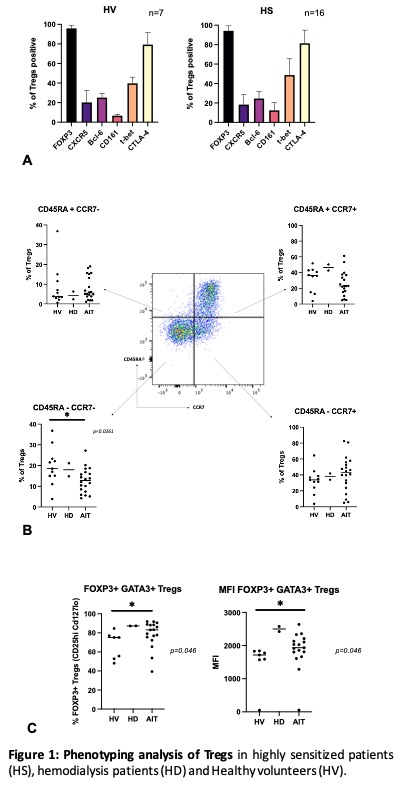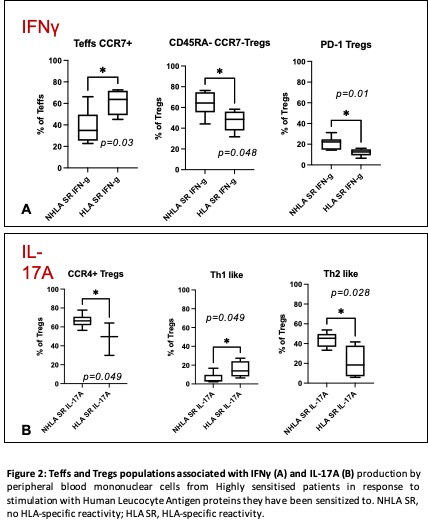Reduced CD45RA-CCR7- Tregs Subtypes in Highly Sensitised Patients Associates with a Failure to Regulate Memory IFNγ Production in Response to Donor Alloantigens
1King's College London, London, United Kingdom, 2Viapath Clinical Transplantation Laboratory, Guy's Hospital, London, United Kingdom
Meeting: 2022 American Transplant Congress
Abstract number: 1267
Keywords: Alloantigens, Highly-sensitized, Kidney transplantation, T cells
Topic: Basic Science » Basic Science » 10 - Treg/Other Regulatory Cell/Tolerance
Session Information
Session Name: Treg/Other Regulatory Cell/Tolerance
Session Type: Poster Abstract
Date: Monday, June 6, 2022
Session Time: 7:00pm-8:00pm
 Presentation Time: 7:00pm-8:00pm
Presentation Time: 7:00pm-8:00pm
Location: Hynes Halls C & D
*Purpose: Highly sensitised (HS) patients exhibit worse long-term outcomes after kidney transplantation compared to non-sensitised patients. It has been hypothesised that regulatory T cells (Tregs) could regulate memory immune alloresponses, however Tregs populations have not been studied in HS populations. IL-17A and IFNγ are cytokines which have been strongly associated with acute and chronic rejection, respectively. This project aims to understand the mechanisms of regulation in cellular memory immune responses in HS patients and whether this function is associated with a specific Treg subpopulation.
*Methods: We prospectively recruited 16 HS patients on dialysis and compared their Tregs and Teffector (Teffs) cell phenotypes with non-sensitised patients on haemodialysis (HD) and 7 healthy volunteers (HV). We tested IFNγ/IL-17A production by CD8-depleted peripheral blood mononuclear cells (PBMC) in response to HLA (human leucocyte antigen) proteins (PureProt®) in FluoroSpot to assess their memory immune alloresponses and linked it with their Treg phenotype.
*Results: Tregs from HS patients shared similarities with Tregs from HV (Figure 1A), but had a smaller proportion of CD45RA-CCR7- effector memory Tregs (1B) and a higher proportion of GATA-3+ Tregs (1C) compared to HV. Stimulation of CD8-depleted PBMCs from HS patients showed HLA specific reactivity (HLA SR) for IFNγ (3/16) or IL-17A (5/16) in response to previously sensitised HLA proteins. IFNγ HLA SR was associated with a higher proportion of CCR7+ Teffs, a smaller proportion of CD45RA-CCR7- and PD1+ Tregs. IL-17A HLA SR was associated with a higher proportion of Th1-like Tregs and a smaller proportion of CCR4+ Tregs and Th2-like Tregs (Figure 2).
*Conclusions: HS patients display a smaller proportion of CD45RA-CCR7- Tregs compared to HV. This was associated with the lack of spontaneous regulation of IFNγ production when stimulated with HLA they have been sensitised to. In contrast, IL-17A dysregulation seems to be associated with different Treg subpopulations.
To cite this abstract in AMA style:
Dudreuilh C, Basu S, Shaw O, Burton H, Domingo-Vila C, Tree T, Lombardi G, Scotta C, Dorling A. Reduced CD45RA-CCR7- Tregs Subtypes in Highly Sensitised Patients Associates with a Failure to Regulate Memory IFNγ Production in Response to Donor Alloantigens [abstract]. Am J Transplant. 2022; 22 (suppl 3). https://atcmeetingabstracts.com/abstract/reduced-cd45ra-ccr7-tregs-subtypes-in-highly-sensitised-patients-associates-with-a-failure-to-regulate-memory-ifn%ce%b3-production-in-response-to-donor-alloantigens/. Accessed December 28, 2025.« Back to 2022 American Transplant Congress


